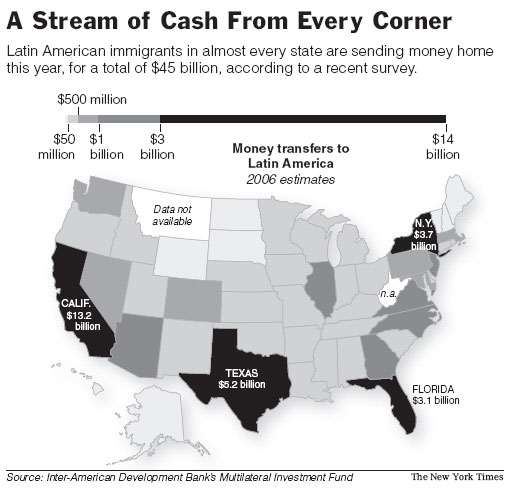| Want to send this page or a link to a friend? Click on mail at the top of this window. |
More Special Reports |
| Posted October 19, 2006 |
 |
Flow of Immigrants' Money To Latin America Surges |
|
|
There is a common cycle to immigration from Latin America. Immigrants arrive in the United States and quickly find work. Several months later — in the case of illegal migrants, as soon as they have finished paying off the smuggler who brought them across the border — they start sending money home.
According to a new report about immigrants’ money transfers to Latin America, the remittances flow from almost every state. Even in states that had virtually no Latin American immigrants only a few years ago, like Mississippi and Pennsylvania, a growing trickle of money is making its way south to places like Tlalchapa, Mexico, or Panajachel, in the Guatemalan highlands.
“Twenty years ago the money was coming from four or five states; now it’s coming from every corner of the country,” said Sergio Bendixen, a Miami pollster who surveyed some 2,500 immigrants, legal and illegal, for the survey on which the report was based.
____________ |
|
From Latinos, $45 billion this year to relatives back home. |
|
____________ |
For the nation as a whole, the flow of money has become a torrent. According to the study, sponsored by the Multilateral Investment Fund of the 47-nation Inter-American Development Bank, remittances from the United States to Latin America this year will total more than $45 billion. That is 51 percent higher than they were only two years ago.
About three-quarters of Latino immigrants who were surveyed send money home regularly, up from some 60 percent in a similar survey in 2004. This may largely reflect growth in the population of illegal immigrants, who tend to send money home more often than others. They accounted for about 40 percent of remitters in the survey, up from a third in 2004.
Moreover, with immigration to the United States a regular part of the life cycle for large numbers of men and women in many parts of Latin America, sending money back to relatives at home has developed into a moral obligation.
“If you don’t send money to your mother, you are a bad son,” Mr. Bendixen said. “Remittances companies say this in their TV ads.”
The study’s estimates on remittances are in line with population figures from the Census Bureau, which found last year that Latin American immigrants made up 6.6 percent of the nation’s household population (that is, excluding people in jail, on military bases and such), more than half the total immigrant population.
The bureau also found that 1.2 percent of the household population of Pennsylvania was born in Latin America, as were 0.7 percent of the population of Ohio and 2 percent of the population of Indiana. These were states with virtually no Latino immigrants five years ago.
According to the data from the Inter-American Development Bank, money transfers from Indiana should approach $400 million this year, with the total from Pennsylvania above $500 million and from Ohio more than $214 million.
Indeed, the study found Latino immigrants sending money from 48 of the 50 states — excluding only Montana and West Virginia, where, Mr. Bendixen said, he did not survey because he expected very few remitters.
In addition to those two states, the survey suffers from very small samples in some with the most recent immigrant populations. But Mr. Bendixen said that in these states, the remittance figures should be off by no more than 10 percent.
The data are consistent with a known pattern in which Latino migrants move from immigrant-heavy states like Illinois to new frontiers like Pennsylvania in search of jobs.
“Somebody who is already here hears about a new plant opening and goes there,” observed Jeffrey S. Passel, a demographer at the Pew Hispanic Institute. “After a while, the word gets back to Mexico, and the migrant stream is no longer from California to a meatpacking plant in Iowa. It’s Mexico to a plant in Iowa.”
The reconstruction of New Orleans after Hurricane Katrina provides an example of how immigrant populations coalesce around jobs. Latino immigrants have flocked to New Orleans, where another study has found that by this summer, they accounted for half the reconstruction force, with 54 percent of them working in the United States illegally.
They too have begun to send money back. According to the bank’s survey, remittances to Latin America from Louisiana should top $200 million this year, a 240 percent increase since 2004.
Copyright 2006 The New York Times Company. Reprinted from The New York Times, National, of Thursday, October 19, 2006.
| Wehaitians.com, the scholarly journal of democracy and human rights |
| More from wehaitians.com |